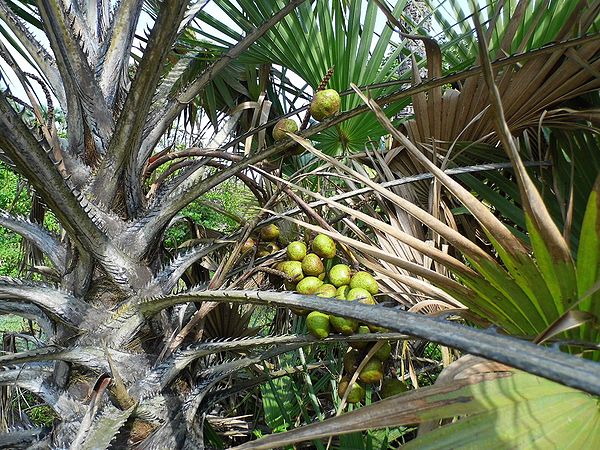Hyphaene guineensis
| Hyphaene (hy-FEHN-eh) guineensis (gwee-neh-EN-sis) | |||||||
|---|---|---|---|---|---|---|---|
 Kinshasa and Kisantu D. R. C. Congo. | |||||||
| Scientific Classification | |||||||
| |||||||
| Synonyms | |||||||
|
| |||||||
| Native Continent | |||||||
|
| |||||||
| Morphology | |||||||
| |||||||
| Culture | |||||||
|
| |||||||
| Survivability index | |||||||
|
| |||||||
| Common names | |||||||
|
| |||||||
Contents
Habitat and Distribution
Angola, Cabinda, Congo, Gabon, Ghana, Guinea-Bissau, Liberia, and Zaire. The Matebeira is native to Africa, and is in a restricted range of seafront, which runs north of Angola (Barra do Kwanza), to Guinea-Bissau. Hyphaene guineensis grows in coastal lowland regions, especially on sandy soils with superficial groundwater; however, it has never been observed growing in inundated areas. This species is mostly distributed from see level to 300 mDescription
Stem to 14 m tall and to 30-35 cm in diameter, frequently solitary or apparently forking below ground and producing 2 stems of more or less the same size; leaves up to 14; fruits pear-shaped of with tree prominent lobes, 6-8 cm long and 6-7 cm wide, pale green when immature, ripening dark red-brown. (Dr. Adama Faye) Editing by edric.
Isolated palm tree, stems with 60-20 m tall, rarely branched and 20-40 cm in diameter. The trunk appears covered with a kind of network formed by the bases of the old leaves. Petiole robust to 150 cm in length, the leaves form a sort of array cut at the ends. Occasionally are observed small flowers . The fruits are depressed oblique format, type of pear-shaped, flattened on the apex , rounded or obtuse, with 5-6.5 cm long and 6-7 cm in diameter. The epicarp has a bright orange color to red-brown and has no core . The mesocarp and the endocarp are hard woody and fibrous. The seeds are of irregular shape approximately following the contour of the fruit, up to 3 cm in diameter, having an endosperm homogeneous, with a central cavity.
Culture
Comments and Curiosities
Uses: The young leaves are used for manufacturing ropes , baskets , bags , belts and hats . The sap extracted from the trunk of Matebeira, is used to make palm wine, known as "maruvo" or "Marufo"
The difficulty in correct classification was due to the confusion of the literature on botany , leading to the identity of Hyphaene guineensis, as described by Thonning, generates an immense tangle of names and identities misinterpreted. A list drawn up of those names is given by Furtado in a publication from 1970. The problem is partly caused by the loss of samples Thonning and subsequent denial of the presence of Hyphaene in humid regions of West African plain, and the overlook and do not take into account the detailed report of the German Loango expedition where Guessfeldt and Peschuel-Loesche, clearly mention the occurrence of H. guineensis " Erect, unbranched, single-stemmed fan palm trees, which grow themselves, in open groups or in extensive orchards, in places with sand along the coastline and never occur in the forest. There is reported that is from the east of Liberia to the Niger Delta and to the south of Angola to 9 08'S, the Kwanza bar ". Later, Furtado, studied various fruits of the type described by Thonning. This allowed Furtado assign a neotype , confirming the coastal habitat H. guineensis Thonning. Other forms of aberrant fruit still obscured the true identity of H. guineensis. However, the newly acquired material from Hyphaene in Gabon possible to evaluate the type of samples in various names Hyphaene, allowing to limit the H. guineensis and demonstrate how it can be distinguished from other species in the genus by having an unusual habitat and meet confined to a precise geographical area where other species are unknown Hyphaene.
- IMAGE GALLERY
External Links
References
Phonetic spelling of Latin names by edric.
Special thanks to Geoff Stein, (Palmbob) for his hundreds of photos.
Special thanks to Palmweb.org, Dr. John Dransfield, Dr. Bill Baker & team, for their volumes of information and photos.
Glossary of Palm Terms; Based on the glossary in Dransfield, J., N.W. Uhl, C.B. Asmussen-Lange, W.J. Baker, M.M. Harley & C.E. Lewis. 2008. Genera Palmarum - Evolution and Classification of the Palms. Royal Botanic Gardens, Kew. All images copyright of the artists and photographers (see images for credits).
Many Special Thanks to Ed Vaile for his long hours of tireless editing and numerous contributions.













